The Cambridge History of China. Vol. 13: Republican China 1912-1949, Part 2
Подождите немного. Документ загружается.

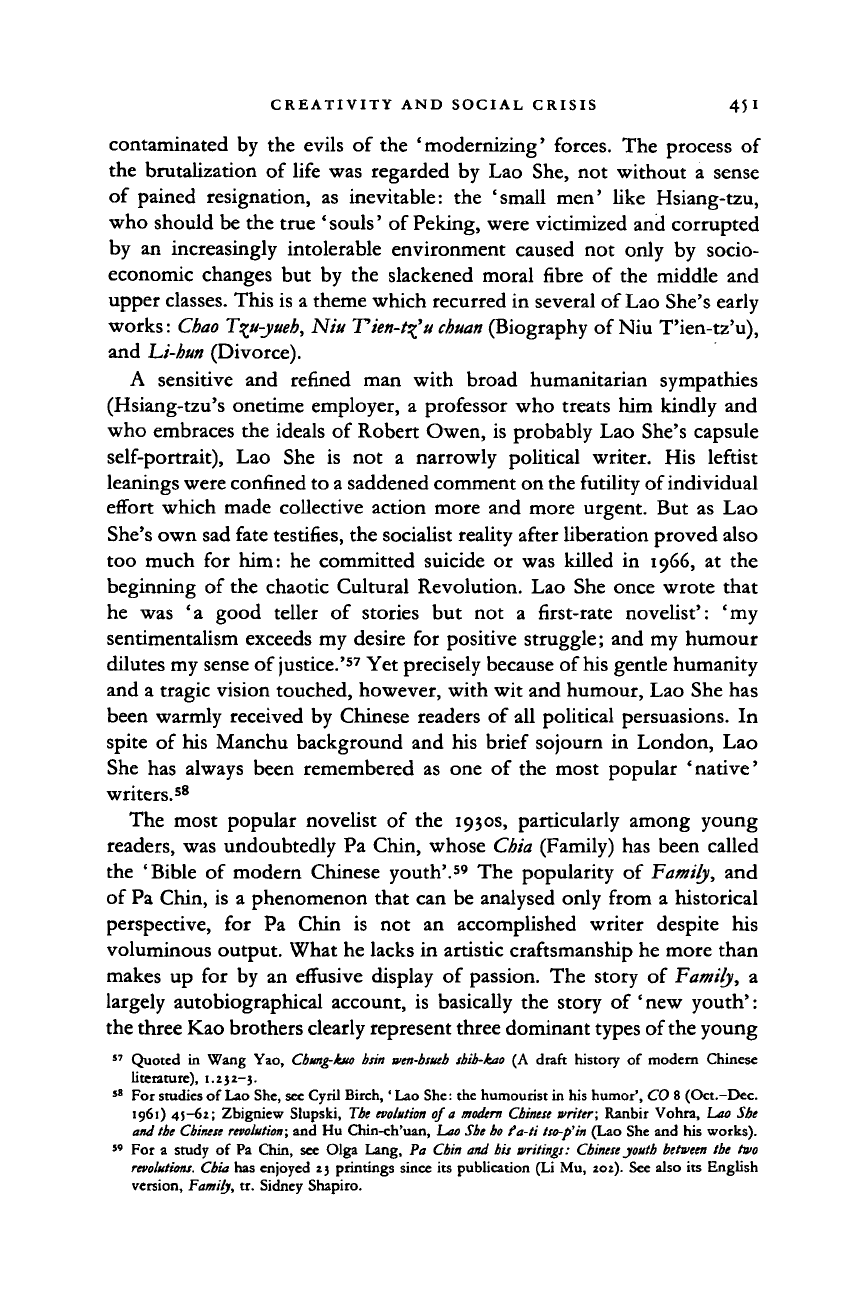
CREATIVITY AND SOCIAL CRISIS 45 I
contaminated by the evils of the ' modernizing' forces. The process of
the brutalization of life was regarded by Lao She, not without a sense
of pained resignation, as inevitable: the 'small men' like Hsiang-tzu,
who should be the true '
souls'
of Peking, were victimized and corrupted
by an increasingly intolerable environment caused not only by socio-
economic changes but by the slackened moral fibre of the middle and
upper classes. This is a theme which recurred in several of Lao She's early
works:
Chao
T^u-yueb,
Niu Tien-t^u
chuan
(Biography of Niu T'ien-tz'u),
and Li-hun (Divorce).
A sensitive and refined man with broad humanitarian sympathies
(Hsiang-tzu's onetime employer, a professor who treats him kindly and
who embraces the ideals of Robert Owen, is probably Lao She's capsule
self-portrait), Lao She is not a narrowly political writer. His leftist
leanings were confined to a saddened comment on the futility of individual
effort which made collective action more and more urgent. But as Lao
She's own sad fate testifies, the socialist reality after liberation proved also
too much for him: he committed suicide or was killed in 1966, at the
beginning of the chaotic Cultural Revolution. Lao She once wrote that
he was 'a good teller of stories but not a first-rate novelist': 'my
sentimentalism exceeds my desire for positive struggle; and my humour
dilutes my sense of justice.'
57
Yet precisely because of
his
gentle humanity
and a tragic vision touched, however, with wit and humour, Lao She has
been warmly received by Chinese readers of all political persuasions. In
spite of his Manchu background and his brief sojourn in London, Lao
She has always been remembered as one of the most popular 'native'
writers.
58
The most popular novelist of the 1930s, particularly among young
readers, was undoubtedly Pa Chin, whose Cbia (Family) has been called
the 'Bible of modern Chinese youth'.
59
The popularity of Family, and
of Pa Chin, is a phenomenon that can be analysed only from a historical
perspective, for Pa Chin is not an accomplished writer despite his
voluminous output. What he lacks in artistic craftsmanship he more than
makes up for by an effusive display of passion. The story of Family, a
largely autobiographical account, is basically the story of
'
new youth':
the three Kao brothers clearly represent three dominant types of the young
57
Quoted
in
Wang
Yao,
Chung-km bsin wen-bsueb sbib-kao
(A
draft history
of
modern Chinese
literature), 1.232-3.
58
For
studies
of
Lao
She, see
Cyril Birch,'
Lao She: the
humourist
in his
humor',
CO 8
(Oct.-Dec.
1961) 45-62; Zbigniew Slupski, Tbe
evolution
of a modern Chinese writer; Ranbir Vohra, Lao She
and tbe
Chinese
revolution;
and Hu Chin-ch'uan, Lao She bo fa-ti tso-p'in (Lao She and his works).
M
For a study of Pa Chin, see Olga Lang, Pa Cbin and bis writings:
Chinese
youth between tbe two
revolutions. Cbia has enjoyed 23 printings since its publication (Li Mu, 202). See also its English
version, Family, tr. Sidney Shapiro.
Cambridge Histories Online © Cambridge University Press, 2008
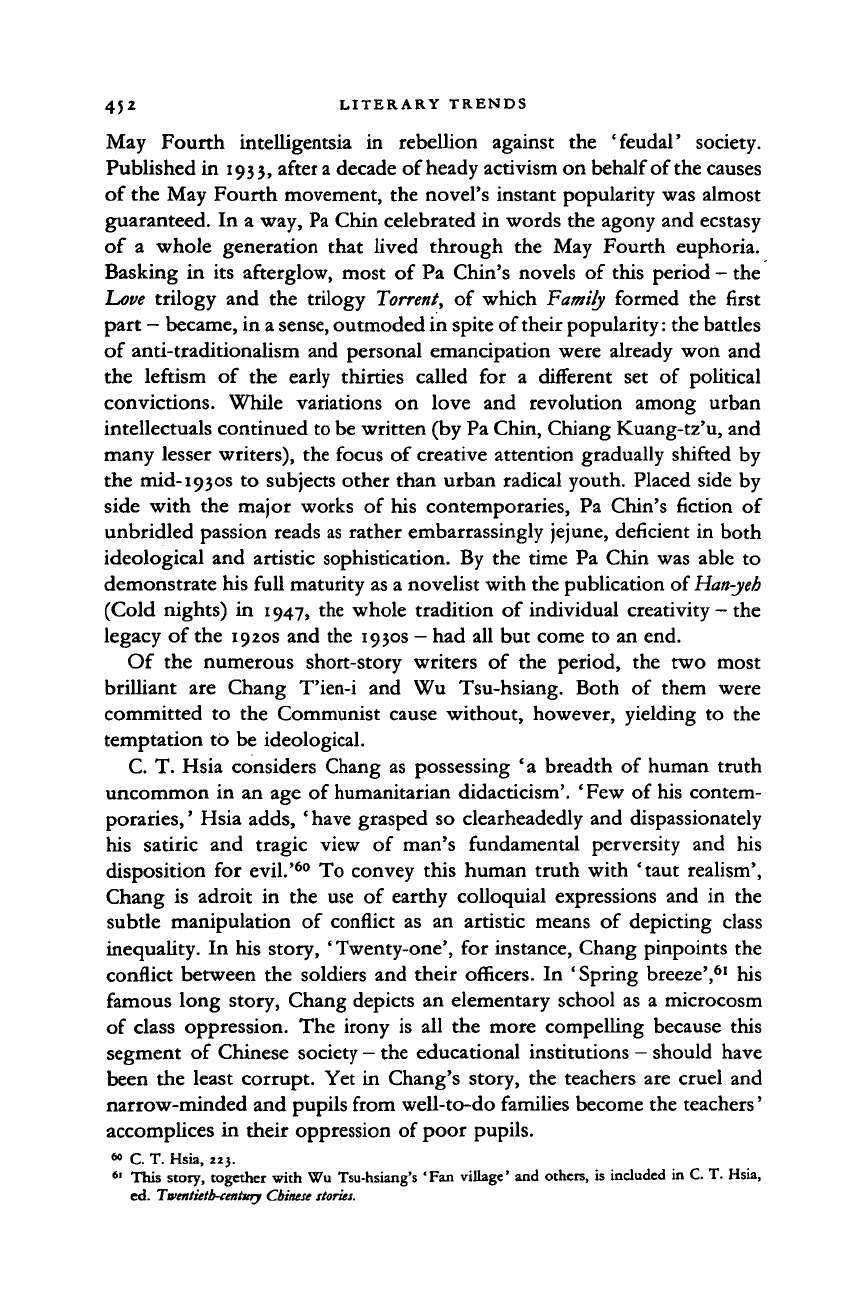
452 LITERARY TRENDS
May Fourth intelligentsia
in
rebellion against
the
'feudal' society.
Published
in
1953, after
a
decade
of
heady activism on behalf of the causes
of the May Fourth movement,
the
novel's instant popularity was almost
guaranteed.
In a
way, Pa Chin celebrated
in
words
the
agony
and
ecstasy
of
a
whole generation that lived through
the May
Fourth euphoria.
Basking
in its
afterglow, most
of Pa
Chin's novels
of
this period
-
the
Love trilogy
and the
trilogy Torrent,
of
which Family formed
the
first
part
-
became, in a sense, outmoded in spite of their popularity: the battles
of anti-traditionalism
and
personal emancipation were already
won and
the leftism
of the
early thirties called
for a
different
set of
political
convictions. While variations
on
love
and
revolution among urban
intellectuals continued to be written (by Pa Chin, Chiang Kuang-tz'u, and
many lesser writers), the focus
of
creative attention gradually shifted
by
the mid-i93os
to
subjects other than urban radical youth. Placed side
by
side with
the
major works
of his
contemporaries,
Pa
Chin's fiction
of
unbridled passion reads as rather embarrassingly jejune, deficient
in
both
ideological
and
artistic sophistication.
By the
time
Pa
Chin
was
able
to
demonstrate his full maturity as a novelist with the publication
of
Han-yeh
(Cold nights)
in
1947,
the
whole tradition
of
individual creativity
—
the
legacy
of
the 1920s
and the
1930s
—
had
all but
come
to an
end.
Of
the
numerous short-story writers
of the
period,
the two
most
brilliant
are
Chang T'ien-i
and Wu
Tsu-hsiang. Both
of
them were
committed
to the
Communist cause without, however, yielding
to the
temptation
to be
ideological.
C.
T.
Hsia considers Chang
as
possessing '
a
breadth
of
human truth
uncommon
in an age of
humanitarian didacticism'.
'Few of
his contem-
poraries,
'
Hsia adds,
'
have
grasped
so
clearheadedly
and
dispassionately
his satiric
and
tragic view
of
man's fundamental perversity
and his
disposition
for
evil.'
60
To
convey this human truth with 'taut realism',
Chang
is
adroit
in the use of
earthy colloquial expressions
and in the
subtle manipulation
of
conflict
as an
artistic means
of
depicting class
inequality.
In his
story,
'
Twenty-one',
for
instance, Chang pinpoints
the
conflict between
the
soldiers
and
their officers.
In
'Spring breeze',
61
his
famous long story, Chang depicts
an
elementary school
as a
microcosm
of class oppression.
The
irony
is all the
more compelling because this
segment
of
Chinese society
-
the educational institutions
-
should have
been
the
least corrupt.
Yet in
Chang's story,
the
teachers
are
cruel
and
narrow-minded and pupils from well-to-do families become the teachers'
accomplices
in
their oppression
of
poor pupils.
» C.
T.
Hsia, Z2j.
61
This story, together with Wu Tsu-hsiang's 'Fan village' and others,
is
included
in
C.
T.
Hsia,
ed.
Twentieth-century Chinese stories.
Cambridge Histories Online © Cambridge University Press, 2008
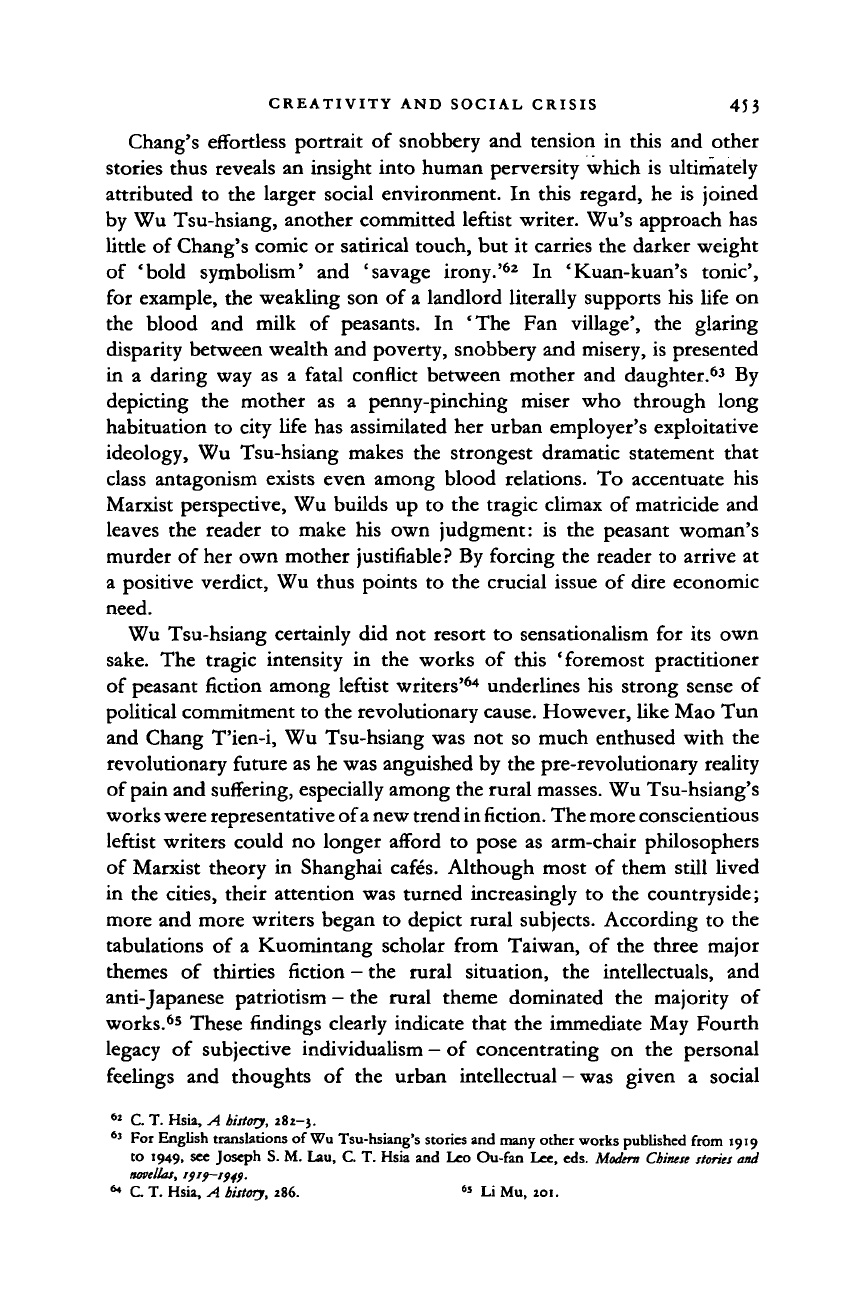
CREATIVITY AND SOCIAL CRISIS 45 3
Chang's effortless portrait of snobbery and tension in this and other
stories thus reveals an insight into human perversity which is ultimately
attributed to the larger social environment. In this regard, he is joined
by Wu Tsu-hsiang, another committed leftist writer. Wu's approach has
little of Chang's comic or satirical touch, but it carries the darker weight
of 'bold symbolism' and 'savage irony.'
62
In 'Kuan-kuan's tonic',
for example, the weakling son of a landlord literally supports his life on
the blood and milk of peasants. In 'The Fan village', the glaring
disparity between wealth and poverty, snobbery and misery, is presented
in a daring way as a fatal conflict between mother and daughter.
63
By
depicting the mother as a penny-pinching miser who through long
habituation to city life has assimilated her urban employer's exploitative
ideology, Wu Tsu-hsiang makes the strongest dramatic statement that
class antagonism exists even among blood relations. To accentuate his
Marxist perspective, Wu builds up to the tragic climax of matricide and
leaves the reader to make his own judgment: is the peasant woman's
murder of her own mother justifiable? By forcing the reader to arrive at
a positive verdict, Wu thus points to the crucial issue of dire economic
need.
Wu Tsu-hsiang certainly did not resort to sensationalism for its own
sake.
The tragic intensity in the works of this 'foremost practitioner
of peasant fiction among leftist writers'
64
underlines his strong sense of
political commitment to the revolutionary cause. However, like Mao Tun
and Chang T'ien-i, Wu Tsu-hsiang was not so much enthused with the
revolutionary future as he was anguished by the pre-revolutionary reality
of pain and suffering, especially among the rural masses. Wu Tsu-hsiang's
works were representative of
a
new trend in fiction. The more conscientious
leftist writers could no longer afford to pose as arm-chair philosophers
of Marxist theory in Shanghai cafes. Although most of them still lived
in the cities, their attention was turned increasingly to the countryside;
more and more writers began to depict rural subjects. According to the
tabulations of a Kuomintang scholar from Taiwan, of the three major
themes of thirties fiction
—
the rural situation, the intellectuals, and
anti-Japanese patriotism
—
the rural theme dominated the majority of
works.
6s
These findings clearly indicate that the immediate May Fourth
legacy of subjective individualism
—
of concentrating on the personal
feelings and thoughts of the urban intellectual
—
was given a social
62
C T.
Hsia,
A
history, 282-3.
63
For English translations
of
Wu Tsu-hsiang's stories and many other works published from 1919
to 1949,
see
Joseph
S. M.
Lau,
C. T.
Hsia and Leo Ou-fan Lee, eds. Modtrn dilute stories and
novellas, 1919-194$.
"CT.
Hsia, A
history,
286.
6s
Li Mu, 201.
Cambridge Histories Online © Cambridge University Press, 2008
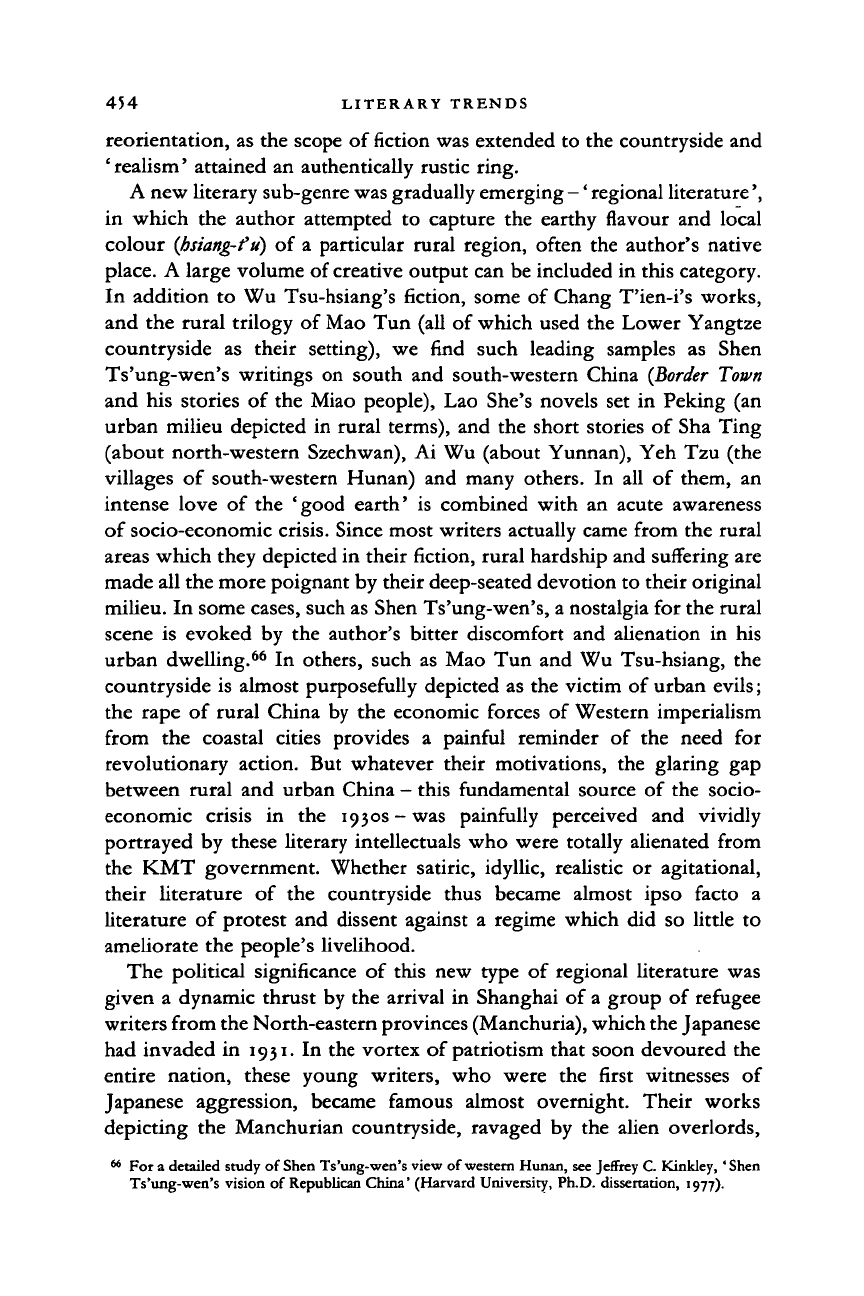
454 LITERARY TRENDS
reorientation, as the scope
of
fiction
was extended to the countryside and
'realism' attained an authentically rustic ring.
A new literary sub-genre was gradually emerging
—'
regional literature',
in which the author attempted
to
capture the earthy flavour and local
colour
{hsiang-fu)
of
a particular rural region, often the author's native
place. A large volume of creative output can be included in this category.
In addition
to
Wu Tsu-hsiang's fiction, some
of
Chang T'ien-i's works,
and the rural trilogy of Mao Tun (all of which used the Lower Yangtze
countryside
as
their setting),
we
find such leading samples
as
Shen
Ts'ung-wen's writings
on
south and south-western China
{Border
Town
and his stories
of
the Miao people), Lao She's novels set
in
Peking (an
urban milieu depicted in rural terms), and the short stories
of
Sha Ting
(about north-western Szechwan), Ai Wu (about Yunnan), Yeh Tzu (the
villages
of
south-western Hunan) and many others.
In all of
them,
an
intense love
of
the ' good earth'
is
combined with
an
acute awareness
of socio-economic crisis. Since most writers actually came from the rural
areas which they depicted in their fiction, rural hardship and suffering are
made all the more poignant by their deep-seated devotion to their original
milieu. In some cases, such as Shen Ts'ung-wen's, a nostalgia for the rural
scene
is
evoked by the author's bitter discomfort and alienation
in
his
urban dwelling.
66
In
others, such as Mao Tun and Wu Tsu-hsiang, the
countryside is almost purposefully depicted as the victim of urban evils;
the rape
of
rural China by the economic forces
of
Western imperialism
from
the
coastal cities provides
a
painful reminder
of
the need
for
revolutionary action. But whatever their motivations, the glaring gap
between rural and urban China
—
this fundamental source
of
the socio-
economic crisis
in the
1930s
-
was painfully perceived
and
vividly
portrayed by these literary intellectuals who were totally alienated from
the KMT government. Whether satiric, idyllic, realistic
or
agitational,
their literature
of the
countryside thus became almost ipso facto
a
literature
of
protest and dissent against
a
regime which did
so
little
to
ameliorate the people's livelihood.
The political significance
of
this new type
of
regional literature was
given
a
dynamic thrust by the arrival in Shanghai of a group
of
refugee
writers from the North-eastern provinces (Manchuria), which the Japanese
had invaded in 1931. In the vortex of patriotism that soon devoured the
entire nation, these young writers, who were
the
first witnesses
of
Japanese aggression, became famous almost overnight. Their works
depicting the Manchurian countryside, ravaged
by
the alien overlords,
66
For a detailed study of Shen Ts'ung-wen's view of western Hunan, see Jeffrey C. Kinkley, 'Shen
Ts'ung-wen's vision of Republican China' (Harvard University, Ph.D. dissertation, 1977).
Cambridge Histories Online © Cambridge University Press, 2008
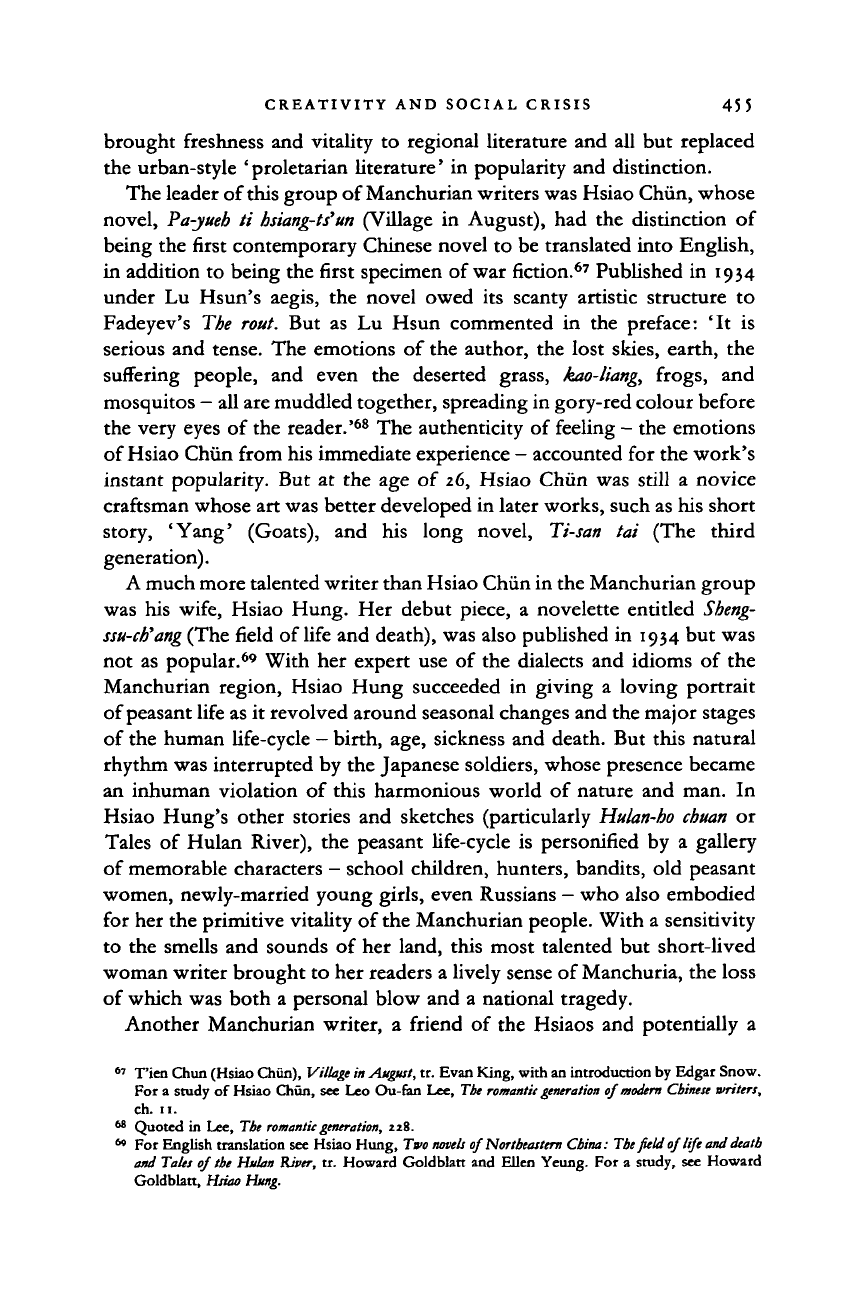
CREATIVITY AND SOCIAL CRISIS 45
5
brought freshness and vitality to regional literature and all but replaced
the urban-style 'proletarian literature' in popularity and distinction.
The leader of this group of Manchurian writers was Hsiao Chun, whose
novel,
Pa-jueb
ti
hsiang-ts'un
(Village in August), had the distinction of
being the first contemporary Chinese novel to be translated into English,
in addition to being the first specimen of war fiction.
67
Published in 1934
under Lu Hsun's aegis, the novel owed its scanty artistic structure to
Fadeyev's The rout. But as Lu Hsun commented in the preface: 'It is
serious and tense. The emotions of the author, the lost skies, earth, the
suffering people, and even the deserted grass, kao-liang, frogs, and
mosquitos
—
all are muddled together, spreading in gory-red colour before
the very eyes of the reader.'
68
The authenticity of feeling
—
the emotions
of Hsiao Chiin from his immediate experience
—
accounted for the work's
instant popularity. But at the age of 26, Hsiao Chiin was still a novice
craftsman whose art was better developed in later works, such as his short
story, 'Yang' (Goats), and his long novel, Ti-san tai (The third
generation).
A much more talented writer than Hsiao Chiin in the Manchurian group
was his wife, Hsiao Hung. Her debut piece, a novelette entitled
Sheng-
ssu-ch'ang
(The field of life and death), was also published in 1934 but was
not as popular.
69
With her expert use of the dialects and idioms of the
Manchurian region, Hsiao Hung succeeded in giving a loving portrait
of peasant life as it revolved around seasonal changes and the major stages
of the human life-cycle - birth, age, sickness and death. But this natural
rhythm was interrupted by the Japanese soldiers, whose presence became
an inhuman violation of this harmonious world of nature and man. In
Hsiao Hung's other stories and sketches (particularly
Hulan-ho chuan
or
Tales of Hulan River), the peasant life-cycle is personified by a gallery
of memorable characters
—
school children, hunters, bandits, old peasant
women, newly-married young girls, even Russians
—
who also embodied
for her the primitive vitality of the Manchurian people. With a sensitivity
to the smells and sounds of her land, this most talented but short-lived
woman writer brought to her readers a lively sense of Manchuria, the loss
of which was both a personal blow and a national tragedy.
Another Manchurian writer, a friend of the Hsiaos and potentially a
67
Tien Chun (Hsiao Chun), Village in August, tr. Evan King, with an introduction by Edgar Snow.
For a study of Hsiao Chun, see Leo Ou-fan Lee, Tbe
romantic generation
of
modern
Chinese writers,
ch. 11.
68
Quoted
in
Lee,
Tie
romantic generation, 228.
60
For English translation see Hsiao Hung, Two novels oj Northeastern China:
Tbe
field of life and death
and Tales of tbe Hulan River, tr. Howard Goldblatt and Ellen Yeung. For a study, see Howard
Goldblatt, Hsiao Hung.
Cambridge Histories Online © Cambridge University Press, 2008
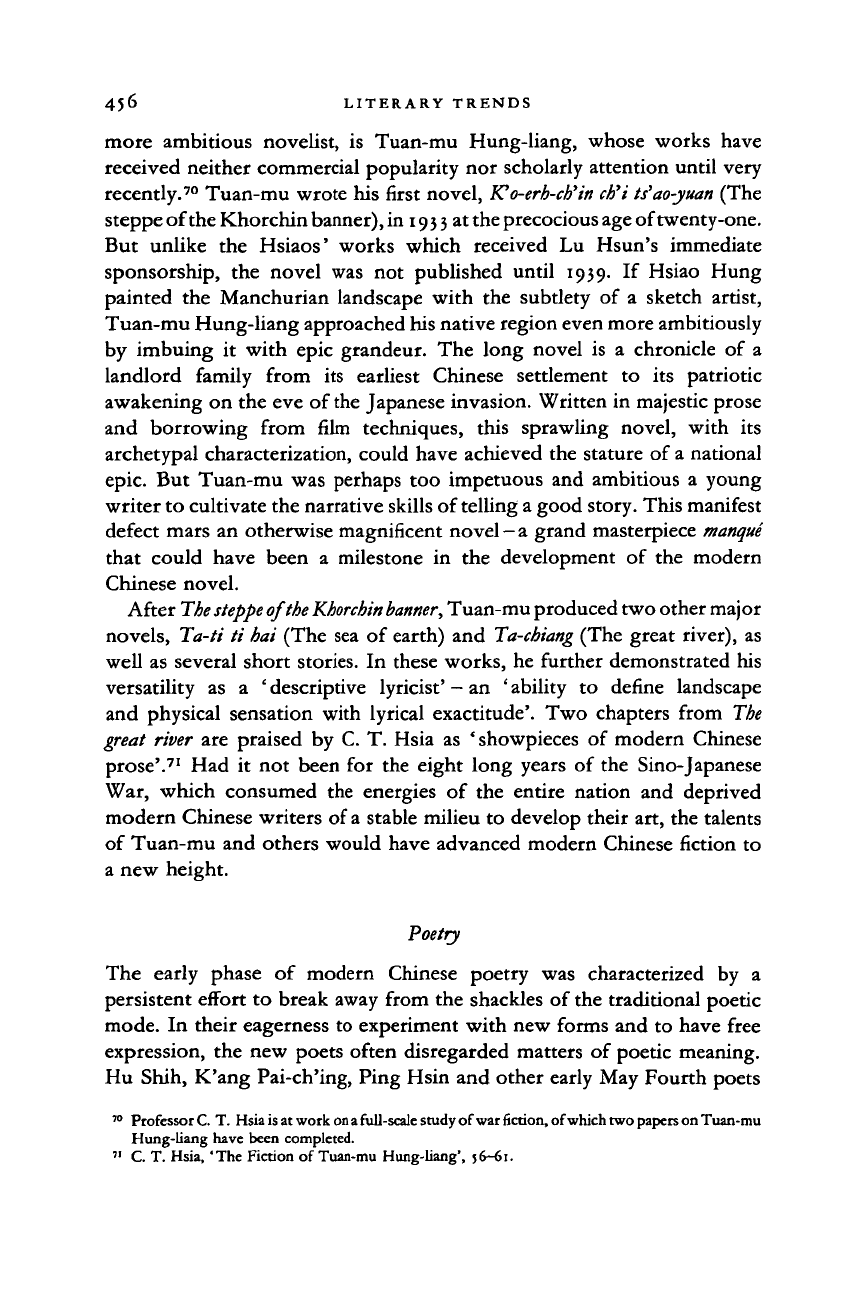
LITERARY TRENDS
more ambitious novelist,
is
Tuan-mu Hung-liang, whose works have
received neither commercial popularity nor scholarly attention until very
recently.
70
Tuan-mu wrote his first novel,
fCo-erh-ch'in ch'i ts'ao-yuan
(The
steppe of the Khorchin
banner),
in 19
3 3
at the precocious
age
of twenty-one.
But unlike
the
Hsiaos' works which received
Lu
Hsun's immediate
sponsorship,
the
novel was
not
published until 1939.
If
Hsiao Hung
painted the Manchurian landscape with the subtlety
of a
sketch artist,
Tuan-mu Hung-liang approached his native region even more ambitiously
by imbuing
it
with epic grandeur. The long novel
is a
chronicle
of a
landlord family from
its
earliest Chinese settlement
to its
patriotic
awakening on the eve of
the
Japanese invasion. Written in majestic prose
and borrowing from film techniques, this sprawling novel, with
its
archetypal characterization, could have achieved the stature of a national
epic.
But Tuan-mu was perhaps too impetuous and ambitious
a
young
writer to cultivate the narrative skills of telling a good story. This manifest
defect mars an otherwise magnificent novel
— a
grand masterpiece
manque
that could have been
a
milestone
in the
development
of
the modern
Chinese novel.
After The steppe of
the
Khorchin
banner,
Tuan-mu produced two other major
novels, Ta-ti
ti
hat
(The sea of earth) and
Ta-chiang
(The great river),
as
well as several short stories. In these works, he further demonstrated his
versatility
as a
' descriptive lyricist'
-
an ' ability
to
define landscape
and physical sensation with lyrical exactitude'. Two chapters from The
great river are praised by C. T. Hsia
as
'showpieces
of
modern Chinese
prose'.
71
Had
it
not been for the eight long years
of
the Sino-Japanese
War, which consumed the energies
of
the entire nation and deprived
modern Chinese writers of
a
stable milieu to develop their art, the talents
of Tuan-mu and others would have advanced modern Chinese fiction
to
a new height.
Poetry
The early phase
of
modern Chinese poetry
was
characterized
by a
persistent effort to break away from the shackles of the traditional poetic
mode. In their eagerness to experiment with new forms and to have free
expression, the new poets often disregarded matters of poetic meaning.
Hu Shih, K'ang Pai-ch'ing, Ping Hsin and other early May Fourth poets
70
ProfessorC. T. Hsiaisatworkonafull-scalestudyofwarficrion,ofwhichtwopapersonTuan-mu
Hung-liang have been completed.
" C. T. Hsia, "The Fiction of Tuan-mu Hung-liang',
56-61.
Cambridge Histories Online © Cambridge University Press, 2008
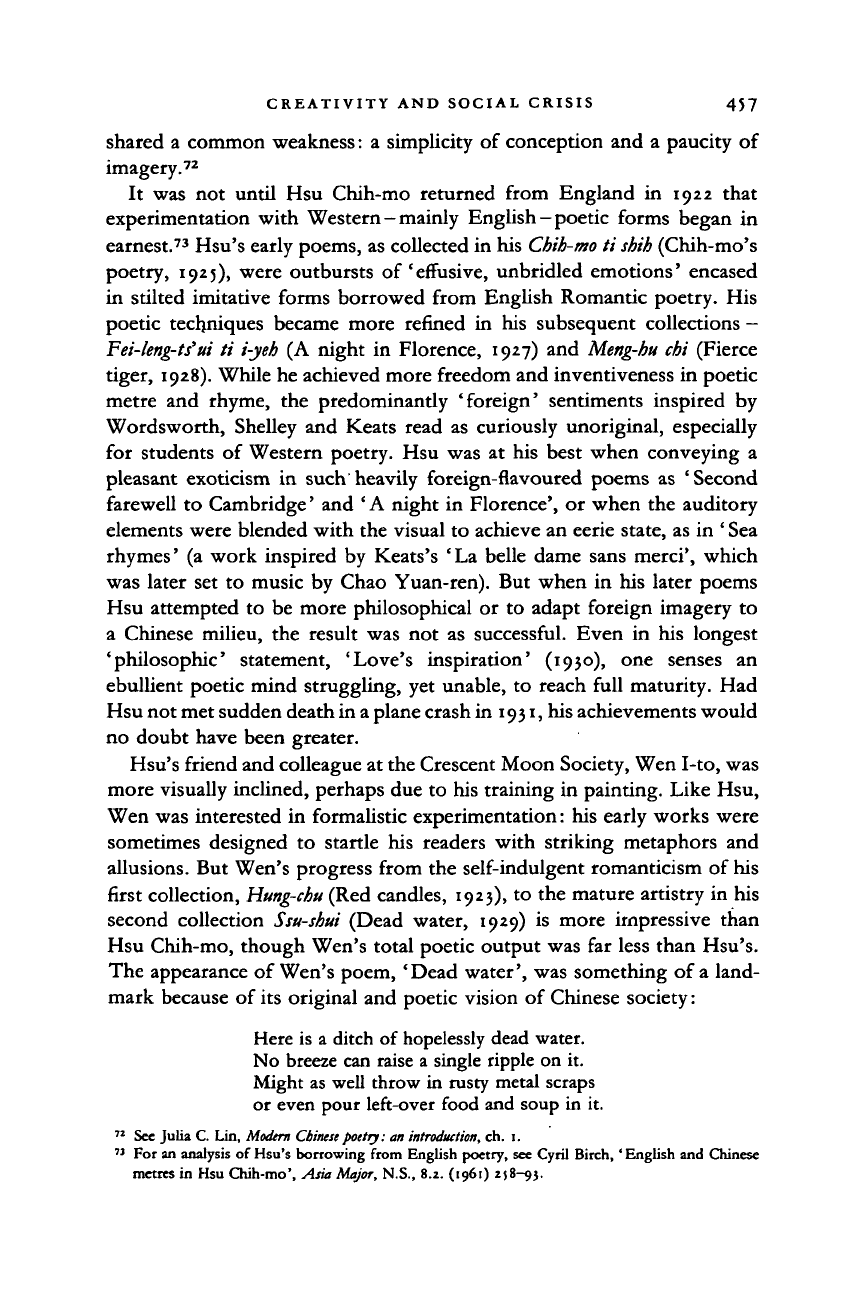
CREATIVITY AND SOCIAL CRISIS 457
shared
a
common weakness:
a
simplicity
of
conception
and a
paucity
of
imagery.
72
It
was not
until
Hsu
Chih-mo returned from England
in 1922
that
experimentation with Western
-
mainly English
-
poetic forms began
in
earnest.
73
Hsu's early poems, as collected
in
his
Chih-mo
ti
shih
(Chih-mo's
poetry, 1925), were outbursts
of
'effusive, unbridled emotions' encased
in stilted imitative forms borrowed from English Romantic poetry.
His
poetic techniques became more refined
in his
subsequent collections
—
Fei-leng-ts'ui
ti
i-jeh
(A
night
in
Florence, 1927)
and
Meng-hu
chi (Fierce
tiger,
1928).
While he achieved more freedom and inventiveness
in
poetic
metre
and
rhyme,
the
predominantly 'foreign' sentiments inspired
by
Wordsworth, Shelley
and
Keats read
as
curiously unoriginal, especially
for students
of
Western poetry.
Hsu was at his
best when conveying
a
pleasant exoticism
in
such heavily foreign-flavoured poems
as
'Second
farewell
to
Cambridge'
and
'
A
night
in
Florence',
or
when
the
auditory
elements were blended with the visual
to
achieve
an
eerie state,
as in '
Sea
rhymes'
(a
work inspired
by
Keats's
'La
belle dame sans merci', which
was later
set to
music
by
Chao Yuan-ren).
But
when
in his
later poems
Hsu attempted
to be
more philosophical
or to
adapt foreign imagery
to
a Chinese milieu,
the
result
was not as
successful. Even
in his
longest
'philosophic' statement, 'Love's inspiration' (1930),
one
senses
an
ebullient poetic mind struggling,
yet
unable,
to
reach full maturity.
Had
Hsu not met sudden death in a plane crash in
1931,
his achievements would
no doubt have been greater.
Hsu's friend and colleague at the Crescent Moon Society, Wen I-to, was
more visually inclined, perhaps due
to
his training
in
painting. Like Hsu,
Wen was interested
in
formalistic experimentation:
his
early works were
sometimes designed
to
startle
his
readers with striking metaphors
and
allusions.
But
Wen's progress from
the
self-indulgent romanticism
of
his
first collection,
Hung-chu
(Red candles, 1923),
to the
mature artistry
in his
second collection
Ssu-shui
(Dead water,
1929) is
more impressive than
Hsu Chih-mo, though Wen's total poetic output was
far
less than Hsu's.
The appearance
of
Wen's poem, 'Dead water', was something
of
a land-
mark because
of
its original
and
poetic vision
of
Chinese society:
Here
is
a ditch
of
hopelessly dead water.
No breeze can raise a single ripple on
it.
Might as well throw
in
rusty metal scraps
or even pour left-over food and soup
in it.
72
See
Julia
C. Lin,
Modern
Chinese
poetry:
an
introduction,
ch. i.
71
For an analysis
of
Hsu's borrowing from English poetry,
see
Cyril Birch,' English and Chinese
metres
in
Hsu Chih-mo', Asia
Major,
N.S., 8.2. (1961) 258-93.
Cambridge Histories Online © Cambridge University Press, 2008
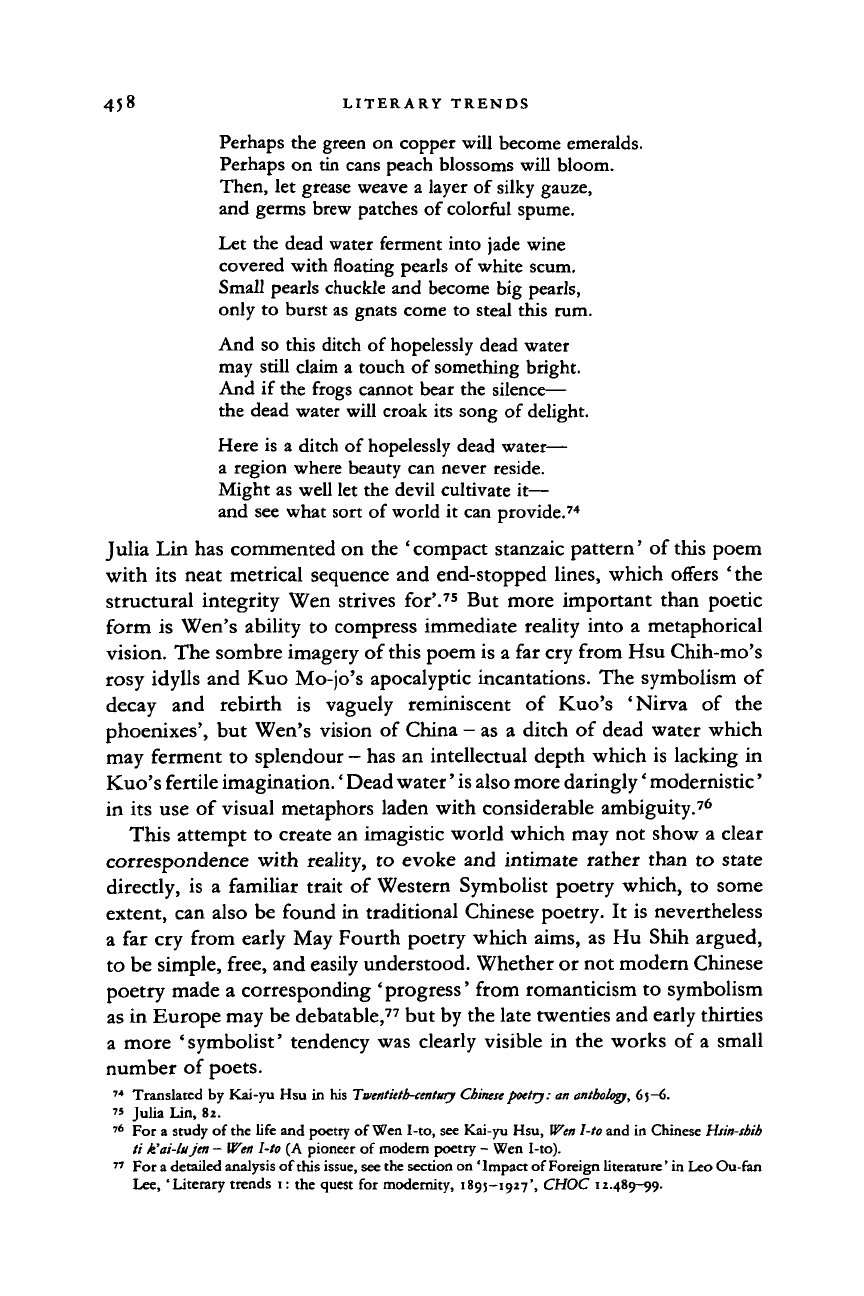
4?8 LITERARY TRENDS
Perhaps the green on copper will become emeralds.
Perhaps on tin cans peach blossoms will bloom.
Then, let grease weave a layer of silky gauze,
and germs brew patches of colorful spume.
Let the dead water ferment into jade wine
covered with
floating
pearls of white scum.
Small pearls chuckle and become big pearls,
only to burst
as
gnats come to steal this rum.
And so this ditch of hopelessly dead water
may still claim a touch of something bright.
And if the frogs cannot bear the silence—
the dead water will croak its song of delight.
Here is a ditch of hopelessly dead water—
a region where beauty can never reside.
Might as well let the devil cultivate it—
and see what sort of world it can provide.
74
Julia Lin has commented on the 'compact stanzaic pattern' of this poem
with its neat metrical sequence and end-stopped lines, which offers 'the
structural integrity Wen strives for'.
75
But more important than poetic
form is Wen's ability to compress immediate reality into a metaphorical
vision. The sombre imagery of this poem is a far cry from Hsu Chih-mo's
rosy idylls and Kuo Mo-jo's apocalyptic incantations. The symbolism of
decay and rebirth is vaguely reminiscent of Kuo's 'Nirva of the
phoenixes', but Wen's vision of China - as a ditch of dead water which
may ferment to splendour
—
has an intellectual depth which is lacking in
Kuo's fertile imagination.' Dead water'
is
also more daringly' modernistic'
in its use of visual metaphors laden with considerable ambiguity.
76
This attempt to create an imagistic world which may not show a clear
correspondence with reality, to evoke and intimate rather than to state
directly, is a familiar trait of Western Symbolist poetry which, to some
extent, can also be found in traditional Chinese poetry. It is nevertheless
a far cry from early May Fourth poetry which aims, as Hu Shih argued,
to be simple, free, and easily understood. Whether or not modern Chinese
poetry made a corresponding ' progress' from romanticism to symbolism
as in Europe may be debatable,
77
but by the late twenties and early thirties
a more 'symbolist' tendency was clearly visible in the works of a small
number of poets.
74
Translated
by
Kai-yu Hsu
in
his Taentietb-century Chinese poetry: an antbolog, 65—6.
75
Julia Lin,
82.
76
For
a
study
of
the life and poetry
of
Wen I-to, see Kai-yu Hsu, Wen
l-to
and
in
Chinese Hiin-sbib
ti k'ai-lujen
—
Wen
l-to (A
pioneer
of
modern poetry
-
Wen I-to).
77
For a detailed analysis of this issue, see the section on'Impact of Foreign literature'in LeoOu-fan
Lee, 'Literary trends
1:
the quest for modernity, 1895—1927', CHOC 12.489-99.
Cambridge Histories Online © Cambridge University Press, 2008
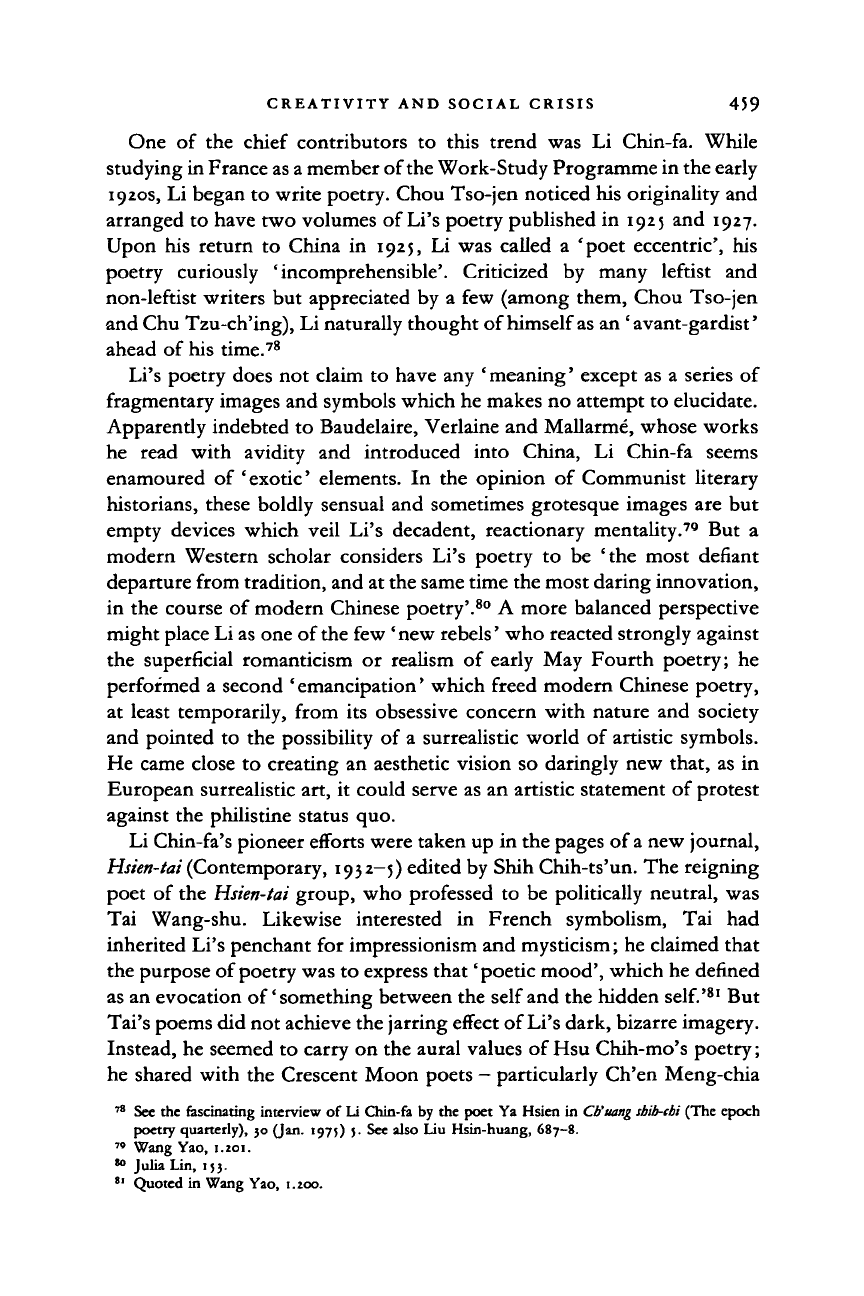
CREATIVITY AND SOCIAL CRISIS 459
One of the chief contributors to this trend was Li Chin-fa. While
studying in France as a member of the Work-Study Programme in the early
1920s, Li began to write poetry. Chou Tso-jen noticed his originality and
arranged to have two volumes of Li's poetry published in 1925 and 1927.
Upon his return to China in 1925, Li was called a 'poet eccentric', his
poetry curiously 'incomprehensible'. Criticized by many leftist and
non-leftist writers but appreciated by a few (among them, Chou Tso-jen
and Chu Tzu-ch'ing), Li naturally thought of himself as an 'avant-gardist'
ahead of his time.
78
Li's poetry does not claim to have any 'meaning' except as a series of
fragmentary images and symbols which he makes no attempt to elucidate.
Apparently indebted to Baudelaire, Verlaine and Mallarme, whose works
he read with avidity and introduced into China, Li Chin-fa seems
enamoured of 'exotic' elements. In the opinion of Communist literary
historians, these boldly sensual and sometimes grotesque images are but
empty devices which veil Li's decadent, reactionary mentality.
79
But a
modern Western scholar considers Li's poetry to be 'the most defiant
departure from tradition, and at the same time the most daring innovation,
in the course of modern Chinese poetry'.
80
A more balanced perspective
might place Li as one of
the
few 'new rebels' who reacted strongly against
the superficial romanticism or realism of early May Fourth poetry; he
performed a second 'emancipation' which freed modern Chinese poetry,
at least temporarily, from its obsessive concern with nature and society
and pointed to the possibility of a surrealistic world of artistic symbols.
He came close to creating an aesthetic vision so daringly new that, as in
European surrealistic art, it could serve as an artistic statement of protest
against the philistine status quo.
Li Chin-fa's pioneer efforts were taken up in the pages of
a
new journal,
Hsien-tai
(Contemporary, 1932-5) edited by Shih Chih-ts'un. The reigning
poet of the
Hsien-tai
group, who professed to be politically neutral, was
Tai Wang-shu. Likewise interested in French symbolism, Tai had
inherited Li's penchant for impressionism and mysticism; he claimed that
the purpose of poetry was to express that' poetic mood', which he defined
as an evocation of'something between the self and the hidden
self.'
81
But
Tai's poems did not achieve the jarring effect of Li's dark, bizarre imagery.
Instead, he seemed to carry on the aural values of Hsu Chih-mo's poetry;
he shared with the Crescent Moon poets - particularly Ch'en Meng-chia
78
See
the
fascinating interview
of li
Chin-fa
by the
poet
Ya
Hsien
in
Cb'uang sbib-fbi (The epoch
poetry quarterly),
30
(Jan. 1975)
5.
See also
Liu
Hsin-huang, 687-8.
70
Wang Yao, 1.201.
80
Julia Lin, 153-
81
Quoted
in
Wang Yao, 1.200.
Cambridge Histories Online © Cambridge University Press, 2008
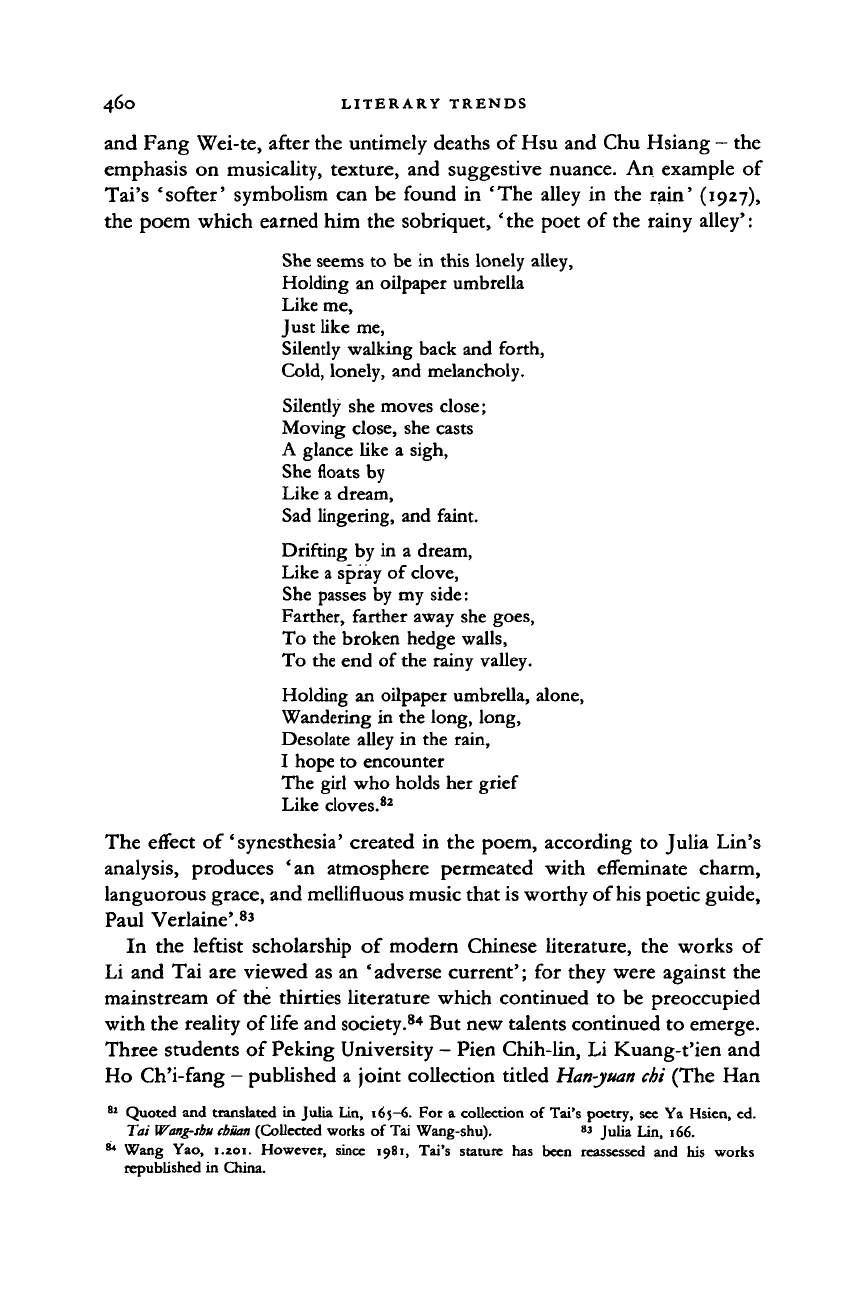
460 LITERARY TRENDS
and Fang Wei-te, after the untimely deaths of Hsu and Chu Hsiang - the
emphasis on musicality, texture, and suggestive nuance. An example of
Tai's 'softer' symbolism can be found in 'The alley in the rain' (1927),
the poem which earned him the sobriquet, ' the poet of the rainy alley':
She seems to be in this lonely alley,
Holding an oilpaper umbrella
Like me,
Just like me,
Silently walking back and forth,
Cold, lonely, and melancholy.
Silently she moves close;
Moving close, she casts
A glance like a sigh,
She
floats
by
Like
a
dream,
Sad lingering, and faint.
Drifting by in a dream,
Like
a
spray of clove,
She passes by my side:
Farther, farther away she goes,
To the broken hedge walls,
To the end of the rainy valley.
Holding an oilpaper umbrella, alone,
Wandering in the long, long,
Desolate alley in the rain,
I hope to encounter
The girl who holds her grief
Like cloves.
82
The effect of 'synesthesia' created in the poem, according to Julia Lin's
analysis, produces 'an atmosphere permeated with effeminate charm,
languorous grace, and mellifluous music that is worthy of his poetic guide,
Paul Verlaine'.
8
*
In the leftist scholarship of modern Chinese literature, the works of
Li and Tai are viewed as an 'adverse current'; for they were against the
mainstream of the thirties literature which continued to be preoccupied
with the reality of life and society.
84
But new talents continued to emerge.
Three students of Peking University - Pien Chih-lin, Li Kuang-t'ien and
Ho Ch'i-fang - published a joint collection titled
Han-yuan chi
(The Han
82
Quoted and translated in Julia Lin, 165-6. For a collection of Tai's poetry, see Ya Hsien, ed.
Tai
Wang-shu cbuan
(Collected works of Tai Wang-shu).
83
Julia Lin, 166.
84
Wang Yao,
I.ZOI.
However, since 1981, Tai's stature has been reassessed and his works
republished in China.
Cambridge Histories Online © Cambridge University Press, 2008
